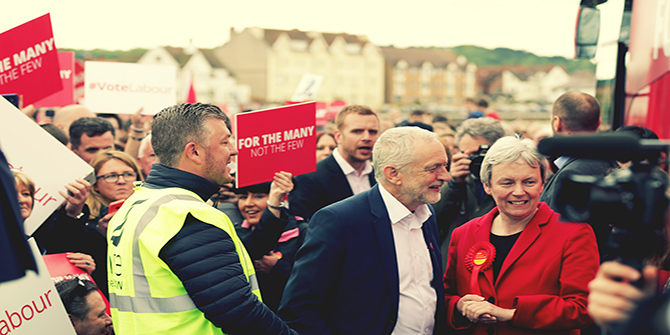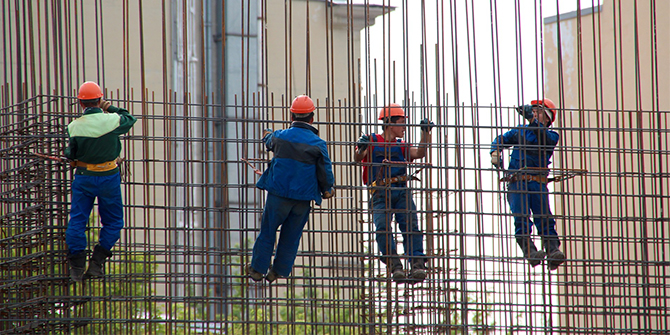 Scottish Labour is in disarray following the general election, having lost 40 of its seats in the country. In this article, Daniel Kenealy outlines what the party must do to rebound: organisationally, the party has to re-energise at a grass-root level; On presentation, Scottish Labour needs to cultivate a new generation of political talent; and substantively, it needs to be bolder on a whole range of policies.
Scottish Labour is in disarray following the general election, having lost 40 of its seats in the country. In this article, Daniel Kenealy outlines what the party must do to rebound: organisationally, the party has to re-energise at a grass-root level; On presentation, Scottish Labour needs to cultivate a new generation of political talent; and substantively, it needs to be bolder on a whole range of policies.
It was, by any measure, devastating. As the results of the UK general election came in through the early hours of Friday 8 May, it became apparent that the Labour party had been virtually wiped out, in Westminster terms, in Scotland. For months the opinion polls had been predicting such a scenario.
The campaign was calamitous. Veering from issue to issue, it failed to settle on a coherent narrative. It was reactive and defensive, spending more time talking about why voting SNP was bad than time talking about why voting Labour was good. The over-arching message, that a vote for the SNP was a vote for the Tories, went down like a lead balloon even with their own supporters.
What has gone wrong for Scottish Labour? The Scottish electorate has stopped listening to them, but why? The answer to that question is a complex one that blends the short-term with the longer-term, and SNP pull factors with Labour push factors.
The onset of devolution in 1999 created a new political forum in to which Labour initially emerged as the most powerful force, leading a coalition government in Scotland for eight years. But Labour had no narrative, no story to tell about the purpose of devolution, and in their eight years in office failed to cultivate a reputation as a competent governing party. Into that vacuum stepped the SNP who became, overnight, the political opposition in post-devolution Scotland.
Eight years later it was the SNP – seen as a battler for Scottish interests, an advocate for more powers for the Scottish Parliament, a competent government in waiting – who took the reigns of government. In the 2011 Scottish election the issue was once again competence and the SNP secured a majority of seats under a proportional electoral system designed specifically to prevent that from happening.
Scotland’s independence referendum acted as a catalyst. It further territorialised politics in Scotland (and contributed to a similar phenomena in England) and brought to the forefront of many voters’ minds the question of who will defend Scotland’s interests best. That Labour joined forces in the referendum campaign with the Conservatives, under the ‘Better Together’ banner, served to further alienate many of its identifiers. The referendum also catalysed another trend, namely the SNP’s growing reputation as the party perceived to be at the heart of progressive politics, change, and social justice.
What needs to be done? The short answer is: a lot. The full answer will not fit in the space of this post. But there are three big areas that need to be tackled: organisational, presentational, and substantive.
Organisationally, the party needs to re-energise at a grass-root level. Scotland’s referendum debate has been noted as having unleashed a tremendous sense of civic activism and engagement. Labour must try to capitalise on some of that, before it’s too late. In particular Scottish Labour needs to think hard about how it can connect with younger voters who are seemingly drawn in far larger numbers to the SNP than to Labour.
There is now a more compelling case than ever for the party in Scotland to become either totally independent or part of a UK-wide federal Labour structure. The review of the party carried out by Jim Murphy and Sarah Boyack in 2011 was not radical enough. The perception of the party in Scotland as a ‘branch office’ weakens it tremendously in an environment where ‘who will stand up for Scotland’ is a major issue in the minds of voters.
On presentation, Scottish Labour needs to cultivate a new generation of political talent. There are figures dotted around the Scottish landscape but too few of them are on the Holyrood benches and too few of them are regularly putting Scottish Labour’s case to the voters on the airwaves.
Substantively, the party needs to be bolder on a whole range of policies. On the issue of further powers for the Scottish Parliament it went into the Smith Commission with a weak set of proposals, allowed the Conservatives to look like the pace-setters, and then came out in late January arguing for more powers than it was prepared to sign-up to in November. It was another sign of the defensive, reactionary nature of the party; chasing headlines instead of sitting down and thinking hard about the principles and powers they think should underpin the next stage of devolution.
Beyond the question of further powers the party needs to be bolder on how it will properly finance further education colleges – a tool of social mobility – even if that means taking tough decisions on university tuition fees. It should come forward with a proposal to replace the council tax with something more progressive. It should bring the best evidence to bear from across the UK on how to integrate health and social care, to generate savings in the face of strapped budgets. The list could go on…
With the resignation of Jim Murphy, after just five months as leader, the party has reached a pivotal moment. Five months ago Kezia Dugdale, a bright, combatant and passionate MSP was elected deputy leader. Many felt then that she was the future of the party but that any such future was some years away. Sometimes, however, you don’t choose your moment, the moment chooses you. The 2016 Holyrood election represents a very steep mountain looming ever larger on the horizon. A drawn-out leadership election that leads to the inevitable conclusion that Kezia Dugdale is the best person for the job would be of little use to the party.
The party has to understand that the repair work needed will take time. Absent some colossal failure Scottish Labour must not seek to blame the next leader for the 2016 Holyrood result. The next leader needs to have a root-and-branch re-think along the organisational, presentational, and substantive dimensions I have sketched above. They need a fresh team of advisers and policy analysts. They need a deputy who, without the burden of a heavy shadow cabinet portfolio, can lead the task of reconnecting the party at the grassroots level (step forward Neil Findlay, the MSP who came second in last year’s leadership race). And they need to do this not for themselves but for Scotland, for a credible alternative government is vital in any democracy.
Note: This article gives the views of the authors, and not the position of the British Politics and Policy blog, nor of the London School of Economics. Please read our comments policy before posting.
 Daniel Kenealy is a Lecturer at the University of Edinburgh Academy of Government.
Daniel Kenealy is a Lecturer at the University of Edinburgh Academy of Government.








More generally, class politics belong to the 20th century, identity politics to this one.
Identity politics has undoubtedly come to the fore, but I think that’s intricately linked to the fallout from the financial crisis. When the economy collapses new forms of identification emerge and grievance/blame seem to follow identity lines. If the economy improves, however, the impetus behind that brand of identity politics diminishes. The narrative becomes less about “whose fault is it” and more about how resources are distributed.